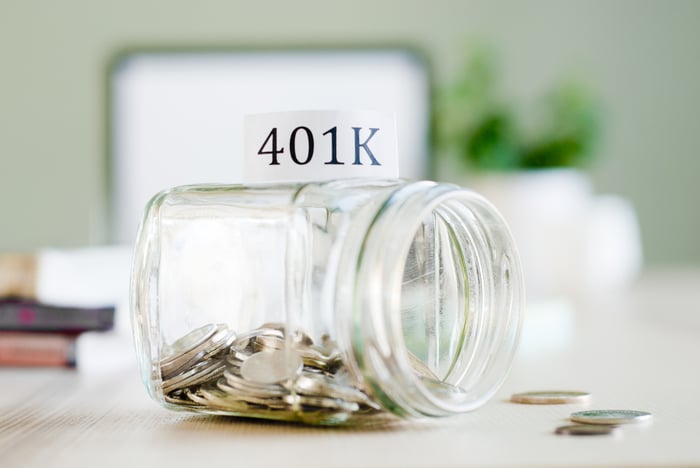Making a plan and sticking to it is necessary to achieve a comfortable retirement.
The average American thinks you need at least $1.46 million to retire comfortably, according to a recent survey from Northwestern Mutual. Unfortunately, most Americans aren’t even close to that number, or even on a path to reach a fraction of it.
That’s a huge problem. With fewer employers offering retirement pensions and potential cuts to Social Security in the future, retirees will have to count more on their own savings. But if you dig into the numbers, the average American’s personal retirement savings are shockingly low.
If you want to set yourself up for a comfortable retirement, you’ll have to do a lot better than average.

Image source: Getty Images.
Here’s how much the average American has saved for retirement
Every three years, the Federal Reserve conducts a Survey of Consumer Finances. The survey includes all sorts of demographic and financial information, including people’s ages, their incomes, and all their investments.
The most recent survey took place in 2022. That year, the average retirement account balance among Americans with a pension, IRA, 401(k), Thrift savings plan, or other employer-sponsored plan was $333,940.
But that number belies the true retirement savings of the typical American.
The median balance is a better reflection of the average retirement account balance. That’s the number half of households with a retirement account have a balance higher than, and half have a lower balance than. That number was $87,000.
Still, those numbers don’t count any households that don’t have any retirement savings at all. And that’s a significant percentage of Americans. As of 2022, 45.6% of American households didn’t have anything saved in retirement accounts.
All those households with no retirement savings drag down the median retirement savings among Americans to just $4,000. Even if you add investments outside of retirement accounts, like individual stocks, bonds, and mutual funds, 50% of American households have less than $9,000 invested.
That’s a far cry from $1.46 million.
In 2022, just 5.2% of American households had total investments or pensions worth more than $1.46 million. So, if you want a comfortable retirement, you’re going to have to do a lot better than average. Here’s how you can set yourself on that path.
Taking advantage of everything available
Retirement accounts like an IRA or 401(k) come with several incentives to help you save for retirement.
The IRA comes with tax incentives. For every dollar you contribute to a traditional IRA, you can deduct it from your tax return. Alternatively, you could contribute to a Roth IRA, pay taxes now, and you won’t have to pay any taxes when you withdraw funds from the account in retirement.
For lower-income households, the government offers the retirement savings contribution tax credit. That credit is a dollar-for-dollar reduction in your tax bill worth up to 50% of your contribution to an eligible retirement account (with a maximum eligible contribution of $2,000).
A 401(k) plan, and other employer-sponsored plans, often come with additional incentives like an employer matching contribution. An employer will put in some amount for every dollar you contribute, up to a specified percentage of your salary.
For anyone still paying off student loans, the SECURE 2.0 Act now allows employers to offer a match for student loan payments instead of contributions to the 401(k). That should allow more workers to start saving for retirement earlier.
Starting early is a big factor in successfully building a sizable retirement account. The earlier you get started, the more time works in your favor. Even if you can only contribute a few dollars per month to your retirement accounts, every little bit helps push you closer to a more comfortable retirement. Importantly, it establishes a habit that you can build upon in the future when you can afford to contribute more to your accounts.
Don’t forget to invest what you save
Contributing is only half the battle. You also need to invest that money in order to see the real benefits of compounding.
The simplest way to invest retirement funds is to use broad-based index funds. The Vanguard S&P 500 ETF (VOO -0.75%) is a favorite among financial experts, including Warren Buffett. If you’re still a couple of decades or more away from retirement, it’s not a bad idea to put all your savings into an all-stock exchange-traded fund (ETF) like the one from Vanguard.
Older investors may want to focus more on capital preservation, but only if they’ve already built a sizable nest egg. Using a bond ETF like the Vanguard Total Bond Market ETF (BND -0.26%) or the Vanguard Intermediate-Term Treasury ETF (VGIT -0.17%) could offer a ballast to the stocks in your portfolio.
All of the above ETFs offer extremely low-cost ways to invest in a broad portfolio of stocks and bonds.
Investors could opt to use a set-it-and-forget-it target date fund. Target date funds automatically adjust your portfolio’s asset allocation over time to become more conservative as you age. This solution won’t work for everyone, though, especially if you’re getting a late start and need to be more aggressive than the typical retirement saver. Also be sure to watch for excessive fees on these types of funds, as they can cost a lot more than a typical index fund depending on the issuer.
All of that said, it’s less important to optimize your portfolio to get the right balance of risk and reward than it is to simply start saving. With all the incentives retirement plans offer, making a plan, any plan, and sticking to it will result in a far better-than-average retirement account balance by the time you’re ready to call it quits.
